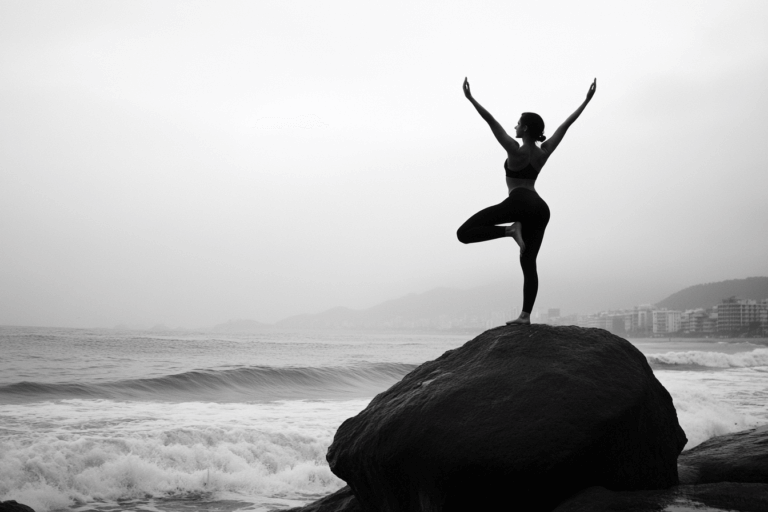As I’ve explored the world of forest bathing practices, I’ve discovered a profound connection with nature that I believe you can experience too. It’s not just about taking a walk in the woods; it’s a mindful practice that engages all your senses and allows you to truly immerse yourself in the natural environment. I’ve found that forest bathing offers a unique way to relieve stress, boost creativity, and improve overall well-being. But there’s so much more to this practice than meets the eye. If you’re curious about how forest bathing can transform your life and deepen your relationship with the natural world, you’re in for an enlightening journey.
Understanding Forest Bathing

Forest bathing, a practice gaining worldwide recognition, isn’t about taking a dip in a woodland stream. It’s a form of nature immersion that invites you to engage with the forest environment using all your senses.
I’ve found that this mindful approach to spending time in nature can profoundly impact your well-being.
As you practice forest bathing, you’ll develop a heightened sensory awareness. You’ll notice the intricate patterns of bark, the whisper of leaves in the breeze, and the earthy scent of the forest floor.
These mindfulness practices help you cultivate a deeper emotional connection with nature.
Forest bathing isn’t just about personal benefits; it’s also about fostering environmental stewardship. As you develop a stronger bond with nature, you’re likely to feel more inclined to protect it.
This practice encourages a reciprocal relationship: as you care for the forest, it nurtures you in return.
Health Benefits of Shinrin Yoku
In light of the growing interest in nature-based wellness practices, shinrin yoku, the Japanese term for forest bathing, has gained attention for its numerous health benefits. As you immerse yourself in the forest atmosphere, you’ll experience a profound sense of calm and connection with nature.
This mindfulness practice offers a powerful antidote to our fast-paced, technology-driven lives.
One of the most significant benefits of shinrin-yoku is stress reduction, contributing to your overall wellbeing. As you breathe in the forest air and absorb the natural surroundings, your cortisol levels decrease, promoting relaxation and emotional healing.
You’ll notice improved mental clarity as the forest environment helps quiet your mind and sharpen your focus.
Shinrin-yoku also provides a remarkable immune boost. The phytoncides released by trees have been shown to increase natural killer cell activity, enhancing your body’s ability to fight off infections and diseases.
By regularly engaging in forest bathing, you’re not only nurturing your mental well-being but also strengthening your physical health.
I encourage you to embrace this holistic practice and discover the transformative power of forest bathing for yourself.
It’s a simple yet profound way to reconnect with nature and cultivate overall wellness.
Getting Started: A Beginner’s Guide to Forest Bathing Practices
Embarking on your first practice of forest bathing can be both exciting and a little daunting. This beginner’s guide will help you prepare for a rewarding journey into nature’s embrace.

What to Wear for Forest Bathing walk
Comfort is key when it comes to forest bathing attire:
- Choose loose, breathable clothing appropriate for the weather
- Wear layers to adapt to temperature changes
- Opt for earth-toned colors to blend with the environment
- Select comfortable, sturdy shoes suitable for walking on uneven terrain
Essential Items to Bring
Pack light, but don’t forget these forest bathing essentials:
- Water bottle to stay hydrated
- Small snack for energy (e.g., nuts or fruit)
- Insect repellent (preferably natural)
- Sunscreen for sun protection
- A small sit pad or lightweight blanket
- A journal and pen for reflection
Mental Preparation
Preparing your mind is as important as packing your bag:
- Set an intention for your forest therapy
- Practice deep breathing exercises before you begin
- Leave your digital devices behind or turn them off
- Approach the experience with an open mind and heart
Choosing Your Forest Bathing Location
Select a suitable location for your first forest bath:
- Find a nearby forest, park, or green space
- Ensure the area is safe and accessible
- Look for a quiet spot away from busy trails
- Consider the time of day for optimal experience (early morning or late afternoon often work best)
Basic Forest Bathing Techniques for Beginners
Start with these simple techniques:
- Mindful walking: Move slowly, focusing on each step
- Sensory activation: Engage all five senses in your surroundings
- Sit spot: Find a comfortable place to sit and observe nature
- Deep breathing: Practice slow, deep breaths to connect with the forest atmosphere
Remember, forest bathing is about quality, not quantity. Even a short 20-minute session can provide significant benefits. As you become more comfortable with the practice, you can extend your time in nature and explore more advanced techniques.By following this beginner’s guide, you’ll be well-prepared for your first forest bathing experience. Embrace the journey and allow yourself to connect deeply with the natural world around you.
Finding Your Forest Bathing Spot
When starting your forest bathing journey, selecting the right spot is essential for a fulfilling experience. I recommend beginning with location scouting in your local area. Look for natural spaces that resonate with you, whether it’s a dense woodland, a serene park, or even a quiet garden.
As you explore, pay attention to your senses and how each environment makes you feel.
Consider these factors during your mindful exploration:
- Accessibility: Choose a spot you can visit regularly
- Safety: Confirm the area is well-maintained and secure
- Biodiversity: Look for diverse plant and animal life
- Privacy: Find a location where you can practice undisturbed
Remember, forest bathing is about sensory immersion, so select a place that engages all your senses.
Notice how seasonal changes affect your chosen spot, as each season offers unique experiences. Use this time for personal reflection, allowing the natural surroundings to guide your thoughts and emotions.
Don’t be afraid to try different locations until you find the perfect fit. Your ideal forest bathing spot should feel like a sanctuary, a place where you can truly connect with nature and yourself.
Essential Forest Bathing Techniques
Now that you’ve found your ideal spot, let’s explore the core techniques of forest bathing.
Begin with deep breathing exercises to center yourself and connect with your surroundings. Inhale the fresh forest air, hold it briefly, and exhale slowly, releasing tension and stress, enhancing your overall wellbeing.
Next, engage in sensory immersion. Close your eyes and listen intently to the rustling leaves, chirping birds, and bubbling streams. Open your eyes and observe the interplay of light and shadow, the vibrant colors, and textures of bark and foliage.
Touch the rough tree trunks, soft moss, and cool earth beneath your feet.
Practice mindful walking, moving slowly and deliberately through the forest. Feel each step as you connect with the ground, maintaining awareness of your body and breath.
Pause frequently to absorb your surroundings.
Try nature journaling to deepen your experience. Sketch what you see, write about your feelings, or compose a haiku inspired by your observations. This practice enhances your connection to the environment.
Walking through nature is like a reset button for the mind, body, and soul.
– Unknown
Incorporating Nature Into Daily Life
Forest bathing doesn’t have to end when you leave the woods. I’ve found that incorporating nature into my daily life has profound effects on my well-being. You can create a deep connection with the natural world, even in urban environments.
Start by taking short nature walks during your lunch break or after work. Practice mindful breathing as you stroll, focusing on the fresh air filling your lungs.
Embrace sensory exploration in your surroundings. Notice the textures of tree bark, the scent of flowers, or the sound of rustling leaves.
Develop daily rituals that bring nature into your routine:
- Keep a small indoor plant and tend to it mindfully
- Open windows to let in natural light and fresh air
- Use nature sounds for relaxation or work focus
- Eat meals outdoors when possible
Outdoor meditation can be a powerful way to connect with nature regularly. Find a quiet spot in a park or your backyard, and practice grounding yourself in the present moment.
Seasonal Forest Bathing: Embracing Nature Year-Round
Forest bathing is a practice that evolves with the changing seasons, offering unique experiences and benefits throughout the year. By attuning yourself to nature’s cycles, you can deepen your connection and reap the full rewards of this mindful practice.
Spring: Awakening and Renewal
As nature bursts into life, spring forest bathing focuses on:
- Observing new growth and budding leaves
- Listening for the return of migratory birds
- Inhaling the fresh scent of spring blossoms
- Feeling the soft, damp earth beneath your feet
Tip: Practice “leaf meditation” by focusing on a single unfurling leaf, observing its intricate details and vibrant color.
Summer: Abundance and Vitality
Summer offers lush, vibrant forests perfect for:
- Seeking shade under dense canopies
- Feeling the contrast between sun-warmed and shaded areas
- Listening to the buzz of insects and rustling leaves
- Tasting wild berries (if safe and permitted)
Tip: Try “forest bathing at dawn” to experience the forest awakening and avoid midday heat.
Autumn: Transformation and Reflection
Fall brings a sensory feast to forest bathers:
- Crunching through fallen leaves
- Admiring the rich palette of autumn colors
- Smelling the earthy scent of decaying leaves
- Observing wildlife preparing for winter
Tip: Engage in “falling leaf meditation” by watching leaves drift to the ground, symbolizing the release of stress and worries.
Winter: Stillness and Introspection
Winter forest bathing offers a unique, serene experience:
- Listening to the muffled quiet of a snow-covered forest
- Observing the intricate patterns of bare tree branches
- Feeling the crisp, cold air on your face
- Noticing signs of life in the seemingly dormant landscape
Tip: Practice “snow walking meditation” by focusing on the crunch of snow under your feet and the patterns your footsteps create.
By embracing seasonal forest bathing, you’ll develop a deeper appreciation for nature’s cycles and your place within them. Each season offers its own lessons in mindfulness, resilience, and connection. Remember to dress appropriately for the weather and always prioritize safety in changing conditions.
As you explore forest bathing throughout the year, you’ll discover that each season has its own rhythm, scent, and energy. This practice not only connects you with nature but also helps you align with the natural ebb and flow of life itself.
Measuring the Impact: Tracking Your Forest Bathing Journey
To truly understand the benefits of your forest bathing practice, it’s essential to track your progress over time. Here are some effective ways to monitor and reflect on your forest bathing journey:
Keep a Forest Bathing Journal
Start a dedicated journal for your forest bathing experiences. After each session, record:
- Date, time, and location of your forest bath
- Weather conditions and seasonal changes
- Your mood before and after the session
- Physical sensations and any changes in energy levels
- Insights or reflections that arose during the practice
Use a Mood Tracking App
Download a mood tracking app to quantify your emotional state before and after forest bathing. Many apps allow you to input custom activities, so you can specifically tag your forest bathing sessions.
Monitor Physical Changes
Track physical indicators of stress reduction:
- Measure your blood pressure before and after sessions
- Use a fitness tracker to monitor heart rate variability
- Note any changes in sleep patterns or quality
Practice Mindful Photography
Take photos during your forest bathing sessions to visually document your journey. Review these images periodically to observe how your perspective and focus may have shifted over time.
Conduct Regular Self-Assessments
Every month or quarter, ask yourself:
- How has my overall stress level changed since starting forest bathing?
- Have I noticed any improvements in my physical health or energy levels?
- Has my connection to nature deepened? If so, how?
- Are there any new habits or perspectives I’ve developed as a result of this practice?
Share Your Experience
Join online forums or local groups focused on forest bathing. Sharing your experiences and hearing from others can provide valuable insights into your own journey.
Set and Review Goals
Establish personal goals for your forest bathing practice, such as frequency of sessions or specific aspects of nature you want to explore. Regularly review and adjust these goals as you progress.By consistently tracking your forest bathing journey, you’ll gain a deeper understanding of its impact on your well-being. This awareness can help you refine your practice and fully appreciate the transformative power of connecting with nature.
Remember, the most important measure of success is your own sense of well-being and connection to the natural world. Let your personal experience guide your forest bathing journey.
Frequently Asked Questions
Can Forest Bathing Be Practiced in Urban Parks or Gardens?
I’ve found urban greenways and parks perfect for nature immersion. I practice mindfulness techniques and heighten my sensory awareness, even in city landscapes. It’s about connecting with nature wherever you are, nurturing your spirit through mindful engagement.
Are There Any Potential Risks or Contraindications to Forest Bathing?
I’d advise you to be mindful of safety precautions. Consider potential allergic reactions, physical limitations, and emotional responses. Environmental factors can affect your experience. It’s important to listen to your body and stay aware of your surroundings.
How Does Forest Bathing Differ From Regular Hiking or Nature Walks?
I’ll tell you, forest bathing’s all about mindfulness techniques and deep sensory engagement. Unlike regular hikes, it’s focused on emotional benefits and environmental connection. You’ll experience true nature immersion, slowing down to fully absorb your surroundings.
Is Forest Bathing Effective in All Seasons, Including Winter?
I believe forest bathing is effective year-round. Winter offers unique seasonal benefits, enhancing mindfulness and sensory awareness. Nature immersion in colder months can boost emotional resilience. I’ve found each season brings its own gifts to the practice.
Can Forest Bathing Be Combined With Other Wellness Practices Like Meditation?
I’ve found combining meditation with forest bathing enhances my nature connection. I’ll use mindfulness techniques, sensory awareness, and breathing exercises while setting intentions. It’s a powerful way to deepen my holistic wellness practice in nature.
Conclusion
I’ve found that embracing forest bathing has transformed my life in profound ways. It’s not just about being in nature; it’s about truly connecting with it. I encourage you to explore these practices and find what resonates with your soul.
Remember, forest bathing isn’t a one-time experience—it’s a journey of continuous discovery and healing. By incorporating these techniques into your daily life, you’ll nurture a deeper bond with the natural world and yourself.







